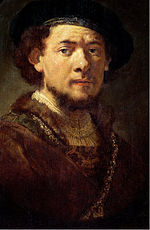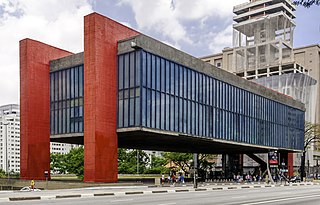
The São Paulo Museum of Art is an art museum located on Paulista Avenue in the city of São Paulo, Brazil. It is well known for its headquarters, a 1968 concrete and glass structure designed by Lina Bo Bardi, whose main body is supported by two lateral beams over a 74 metres (243 ft) freestanding space. It is considered a landmark of the city and a main symbol of modern Brazilian architecture.

Lina Bo Bardi, born Achillina Bo, was an Italian-born Brazilian modernist architect. A prolific architect and designer, she devoted her working life, most of it spent in Brazil, to promoting the social and cultural potential of architecture and design. While she studied under radical Italian architects, she quickly became intrigued with Brazilian vernacular design and how it could influence a modern Brazilian architecture. During her lifetime it was difficult to be accepted among the local Brazilian architects, because she was both a "foreigner" and a woman.

Lasar Segall was a Lithuanian Jewish and Brazilian painter, engraver and sculptor. Segall's work is derived from impressionism, expressionism and modernism. His most significant themes were depictions of human suffering, war, persecution and prostitution.
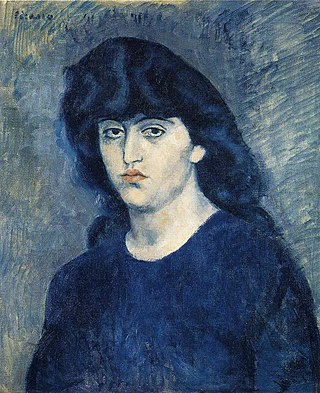
Portrait of Suzanne Bloch is an oil on canvas painting executed by the Spanish artist Pablo Picasso in Paris in 1904, towards the end of his Blue Period. The subject, Suzanne Bloch, was a singer known for her Wagner interpretations, and the sister of the violinist Henri Bloch. The painting is housed in the São Paulo Museum of Art.

The Resurrection of Christ (1499–1502), also called The Kinnaird Resurrection, is an oil painting on wood by the Italian High Renaissance master Raphael. The work is one of the earliest known paintings by the artist, executed between 1499 and 1502. It is probably a piece of an unknown predella, though it has been suggested that the painting could be one of the remaining works of the Baronci altarpiece, Raphael's first recorded commission. The painting is now in the São Paulo Museum of Art.
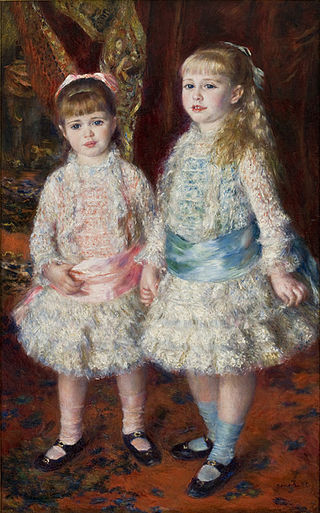
Alice and Elisabeth Cahen d’Anvers is an oil painting by French impressionist Pierre-Auguste Renoir. Produced in Paris in 1881, the painting depicts the sisters Alice and Elisabeth, daughters of Louise Cahen d'Anvers and her husband the Jewish banker Louis Raphaël Cahen d'Anvers. It is considered one of the most popular works in the collection of the São Paulo Museum of Art, where it has been conserved since 1952.

The Ill-Matched Marriage is an oil painting by a follower of the early Netherlandish master Quentin Matsys, usually dated between 1525 and 1530. The panel, probably inspired by an original lost drawing of Leonardo da Vinci, illustrates a marriage for economic reasons between persons of different ages. The painting is in the São Paulo Museum of Art. It was donated to the museum in 1965 by the Baron Hans Heinrich Thyssen-Bornemisza.

The Virgin and Child with the Infant Saint John the Baptist is a tempera painting on wood executed by the Italian Renaissance master Sandro Botticelli and his studio. The tondo, painted in Florence between the years of 1490 and 1500, addresses a central theme of the Italian Renaissance art: the divine motherhood. The work is now in the São Paulo Museum of Art.

The Museum of Contemporary Art, University of São Paulo is a contemporary art museum located in the main campus of the University of São Paulo, in São Paulo, Brazil, and in Ibirapuera Park, in the same city. It is one of the largest art museums in the country.
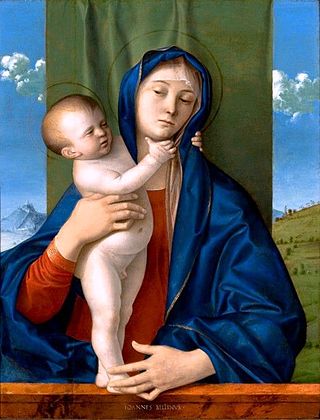
Virgin with the Standing Child, Embracing his Mother, also known as Willys Madonna is a painting by the Italian Renaissance master Giovanni Bellini. It is now in the São Paulo Museum of Art in São Paulo, Brazil.
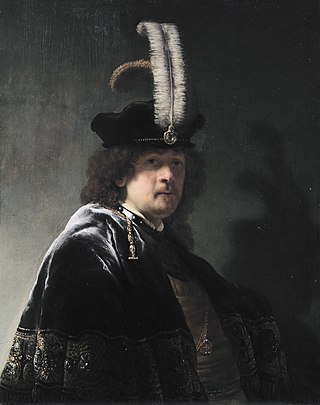
Self-portrait wearing a white feathered bonnet is an oil painting attributed to the Dutch painter Rembrandt. It is signed and dated 1635. It was traditionally regarded as a Rembrandt self-portrait until 1968, when it was rejected on stylistic grounds in the Rembrandt catalogue raisonné by Horst Gerson. In 2013, art historian Ernst van de Wetering re-attributed the painting as an original Rembrandt. It is one of over 40 painted self-portraits by Rembrandt.

Emmanuel Hector Zamor was a Brazilian-born painter who lived in France. He specialized in landscapes and still lifes in the style of the Barbizon school.

The Museum of Sacred Art of São Paulo a museum dedicated to the collection and display of sacred art of Brazil. It is located in the Luz neighborhood of São Paulo in the left wing of the Luz Monastery, a religious institution founded in 1774 by Frei Galvão. The monastery is the only colonial building of the eighteenth century in São Paulo to preserve its original building elements, materials and structure. The monastery was listed as an architectural monument of national importance in 1943 by the National Institute of Historic and Artistic Heritage (IPHAN) and subsequently by the State of São Paulo Council for the Defense of the Historical, Archaeological, Artistic and Touristic Heritage (CONDEPHAAT).
Waldemar Cordeiro was an Italian-born Brazilian art critic and artist. He worked as a computer artist in the early days of computer art and was a pioneer of the concrete art movement in Latin America.
Judith Lauand was a Brazilian painter and printmaker. She is considered a pioneer of the Brazilian modernist movement that started in the 1950s, and was the only female member of the concrete art movement based in São Paulo, the Grupo Ruptura.
Geraldo de Barros was a Brazilian painter and photographer who also worked in engraving, graphic arts, and industrial design. He was a leader of the concrete art movement in Brazil, co-founding Grupo Ruptura and was known for his trailblazing work in experimental abstract photography and modernism. According to The Guardian, De Barros was "one of the most influential Brazilian artists of the 20th century." De Barros is best known for his Fotoformas (1946-1952), a series of photographs that used multiple exposures, rotated images, and abstracted forms to capture a phenomenological experience of Brazil's exponential urbanization in the mid-twentieth century.

Self-Portrait or Self-Portrait in a Black Cap is a c.1637 self-portrait by Rembrandt or portrait of the artist by his studio. It was bought as a self-portrait in 1848 by Richard Seymour-Conway and is now in the Wallace Collection in London. Until recently it was thought to be a workshop copy, but is now mostly accepted as by Rembrandt himself.

Alice Brill was a German-born Brazilian photographer, painter, and art critic.

Wildenstein & Company, a private art dealership, was founded in Paris by Nathan Wildenstein in the mid-19th century and run by his family ever since. The Wildenstein Institute, established by Nathan's son Georges, maintains one of the largest art history reference libraries in the world.

